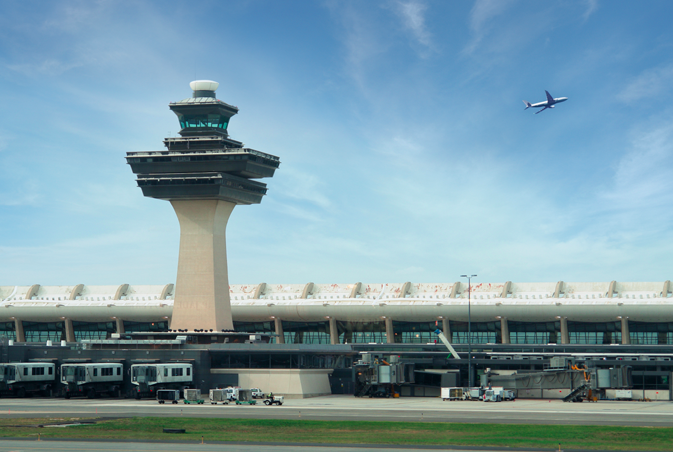ENO CENTER FOR TRANSPORTATION
Introduction
 There are more than 3,330 publicly owned airports as part of the national system in the United States today. These airports move more than 2.5 million passengers each day safely and effectively, and they contribute $76 billion in total output to the American economy. There is also substantial evidence that airports play a major role in regional economies.
There are more than 3,330 publicly owned airports as part of the national system in the United States today. These airports move more than 2.5 million passengers each day safely and effectively, and they contribute $76 billion in total output to the American economy. There is also substantial evidence that airports play a major role in regional economies.
But there are also considerable challenges. In 2013, an Eno report showed the runway and terminal capacity at the nation’s major airports would be unlikely to accommodate projected growth in passengers over the next 20 years. The head of an airport trade group recently argued that airports are “at the breaking point” and need $75 billion of capital investments in the next few years. President Donald Trump and former Vice President Joseph Biden, who each referred to airports in metropolitan New York as “third-world”, famously buoyed this perception of major airport infrastructure defciencies. While there is evidence many airports in the United States clearly benefit from competent public governance, critics disagree. One prominent analysis from 2008 argued that the reason for excessive fight delays is partly due to the failure of “publicly owned and managed airports” to improve their efficiency.
It is no wonder that the call to privatize U.S. commercial airports has recently gotten louder. Advocates for increased privatization cite it as a means to raise one-time government revenues, increase airport investment, and remove politics from airport decision making. Commercial airports also represent an ideal potential private investment because of their consistent revenue sources from parking, landing, and concession fees. Unlike most highways and transit systems, airports regularly cover their costs with revenues from their facilities. Investment in airport infrastructure makes the facility more attractive to airlines and passengers, increasing revenues for investment return and meeting the public-sector goal of increasing airport use.
In addition, examples abroad show that airports often opt for mixed or full privatization. One comprehensive survey found that 41 percent of all European airports have some share of private ownership, compared with only one airport in the United States. However, passengers give these airports mixed reviews. According to a “the best in the world” passenger survey, 32 European airports rank in the top 100. Of those, 20 are public or run by a nonprofit, and 11 are private or mostly private. Meanwhile, all 15 U.S. top-ranked airports are fully public, but only five rank in the top 50 globally. While privatization is still more prevalent abroad, the U.S. context is starkly different because tax-exempt municipal debt can provide a cheaper alternative to private investment.
In other words, despite its worldwide attention, calls for airport privatization in the United States and the problems stakeholders are trying to solve are unproductively disconnected. Therefore, it is important to investigate the complexities of U.S. airport governance and lessons learned from past privatization experiences. This discussion is especially timely because of several major policy moves occurring today.
Renewed discussions about the role of the private sector in infrastructure broadly and transportation specifically are not entirely related to airport privatization. Cities, states, and metropolitan areas across the country are exploring new kinds of partnerships with private firms on everything from urban mobility, highways, to public transit. Most notably, the Trump administration recently proposed spinning off the nation’s air traffic control system from the federal government into a nonprofit entity separate from, but overseen by, the national government. But the circumstances that qualify privatization of air traffic control or a highway as sound policy are not necessarily universal to other projects or types of infrastructure. These disparate debates complicate the discussions about airport privatization.
Related is the push for airport privatization coming from Washington. In its infrastructure proposal, the administration recommended privatizing several government assets including two airports in metropolitan Washington owned by the federal government. It also called for the expansion of a federal pilot program on private ownership of airports. The proposal was recently taken up by Congress and incorporated by the House of Representatives into a proposal to reauthorize the Federal Aviation Administration.
The purpose of this report is to analyze the outcomes of airport privatization in the United States, describe different models for the role of private firms in airports, examine the federal pilot program and its participating airports, and discuss key implications for both the public and private sectors. We find that while airport privatization may be attractive in some circumstances, policymakers first need to clearly understand the problem they are trying to solve and determine whether privatization is the best approach.
Download full version (PDF): Deal or No Deal
About the Eno Center for Transportation
https://www.enotrans.org/
The Eno Center for Transportation is an independent, nonpartisan think tank whose vision is for an American transportation system that fosters economic vitality and improves the quality of life for all. The mission of Eno is to cultivate a creative and innovative workforce and to impact emerging issues for the nation’s multi-modal transportation system.
Tags: airports, Eno, Eno Center for Transportation, FAA, Federal Aviation Administration, Privatization






 RSS Feed
RSS Feed